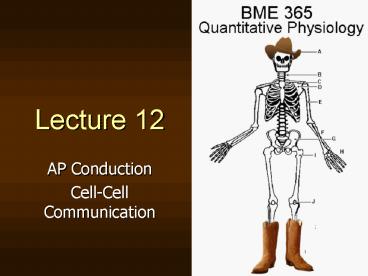AP Conduction - PowerPoint PPT Presentation
1 / 35
Title:
AP Conduction
Description:
Major equations used by Hodgkin-Huxley to mathematically model ... Seven classes of neurotransmitters: Acetylcholine. Amino acids. Amino acid derived amines ... – PowerPoint PPT presentation
Number of Views:71
Avg rating:3.0/5.0
Title: AP Conduction
1
Lecture 12
- AP Conduction
- Cell-Cell Communication
2
Review of Lecture 11
- Revised circuit model of membrane
- Hodgkin Huxley Model of AP
3
Hodgkin-Huxley Equations
- Major equations used by Hodgkin-Huxley to
mathematically model action potential - CmdV/dt-36n4(V-VK)-120m3h(V-VNa)-0.3(V-VL)
- dm/dt am(Vm)(1-m)-bh(Vm)(m)
- dn/dtan(Vm)(1-n)-bn(Vm)(n)
- dh/dt ah(Vm)(1-h)-bh(Vm)(h)
- Four coupled ODEs with highly non-linear terms
- Cannot solve analytically
- Difficult to motivate solution in intuitive way
4
Ion Channel Conductance
- Potassium channels
- gK36n4
- 4 open n gates which work together
- n is a time dependent probability that any one
gate is open - a,b ? voltage dependent rate constants
- dn/dt an(V)(1-n)-bn(V)(n)
5
Ion Channel Conductance
- Sodium channels
- gNa120m3h
- Two types of gates
- Three m gates ? open
- One h gate ? close
- dh/dt ah(V)(1-h)-bh(V)(h)
- dm/dt am(V)(1-m)-bh(V)(m)
6
HH Summary
http//biolpc22.york.ac.uk/hh/hh_excel.html
7
Outline
- Propagation of Action Potentials
- Synapse
- Ion Channel Structure
8
Outline
- Propagation of Action Potentials
- Synapse
- Ion Channel Structure
9
Conduction of AP Along Neuron
- What if we remove the space clamp that we
inserted last time? - Now VV(x,t)
- Divide membrane into patches of length dx
- Set up model in terms of incremental variables
10
Fig 3.6 Cellular Biophysics Electrical
Properties Weiss
11
Derivation of Cable Equation
- Circuit diagram
- Step One
- KVL along inner/outer membrane
- Step Two
- KCL
- Cable Equation
12
Fig 3.11 Cellular Biophysics Electrical
Properties Weiss
13
(No Transcript)
14
Outline
- Propagation of Action Potentials
- Synapse
- Ion Channel Structure
15
Synapse
- Point at which neuron meets its target cell
- Three parts
- Axon terminal of pre-synaptic cell
- Synaptic cleft
- Membrane of post-synaptic cell
- Cell can from many synapses
- Average 10,000
- CNS 150,000
- Two types
- Electrical
- Chemical
16
Fig 8.19 A chemical synapse Silverthorn 2nd
Ed
17
Types of Synapses
- Electrical
- Pass electrical signal directly through gap
junctions - Uncommon, occur mostly in CNS
- Allow rapid signal conduction
- Chemical
- Vast majority of synapses
- Use neurotransmitter to carry information
18
Chemical Synapses
- AP reaches axon terminal
- Voltage gated calcium channels in axon open
- Calcium moves into axon, binds to regulatory
proteins and initiates exocytosis - Exocytosis of neurotransmitter vesicles releases
neurotransmitter into synaptic cleft - Neurotransmitter diffuses across cleft and binds
with membrane receptors on post-synaptic cell - Initiates response in post-synaptic cell
- Excitatory (opens Na channels)
- Inhibitory (opens K channels)
19
Fig 8.21 Synthesis and recycling of
acetylcholine at the synapse Silverthorn 2nd Ed
20
Neurotransmitters
- Seven classes of neurotransmitters
- Acetylcholine
- Amino acids
- Amino acid derived amines
- Polypeptides
- Purines
- Gases
- Lipids
21
Neurotransmitter Receptors
- Two types
- Ligand gated ion channels ? Fast
- G-protein linked receptors ? Activate 2nd
messenger system which opens or closes ion
channels ? Slow
22
Fig 8.20 Events at the synapse Silverthorn
2nd Ed
23
Fig 8.22 Fast and slow responses in
postsynaptic cells Silverthorn 2nd Ed
24
Table 8.3 Major Neurocrines Silverthorn
2nd Ed
25
Models of Synaptic Transmission
- Synaptic transmission has quantal nature
- Ach is packaged into discrete vesicles
- An integer number of vesicles are released
- Particularly apparent at low calcium concentration
26
Fig 7.2 Mathematical Physiology Keener
27
Models of Synaptic Transmission
- n ACh vesicles at presynaptic terminal, each
with same amount of ACh - p probability of 1 vesicle release
- Probability that k sites fire?
28
Fig 7.4 Mathematical Physiology Keener
29
Pre-Synaptic Voltage Gated Calcium Channels
- In synaptic transmission
- AP reaches nerve terminal
- Opens voltage gated calcium channels
- Influx of calcium
- Neurotransmitter release
- Voltage gated calcium channel
- Consists of n identical subunits
- Each can be open (Op) or shut (S)
- All subunits must be open to conduct calcium
30
Fig 7.5 Mathematical Physiology Keener
31
Outline
- Propagation of Action Potentials
- Synapse
- Ion Channel Structure
32
2003 Nobel Prize in Chemistry
- The Atomic Basis of Selective Ion Conduction in
Potassium Channels - http//nobelprize.org/chemistry/laureates/2003/mac
kinnon-lecture.html
33
Summary
- Propagation of Action Potentials
- Synapse
- Ion Channel Structure
34
Poem of the Day
35
Due Dates
- Tuesday, October 12th
- HW6































